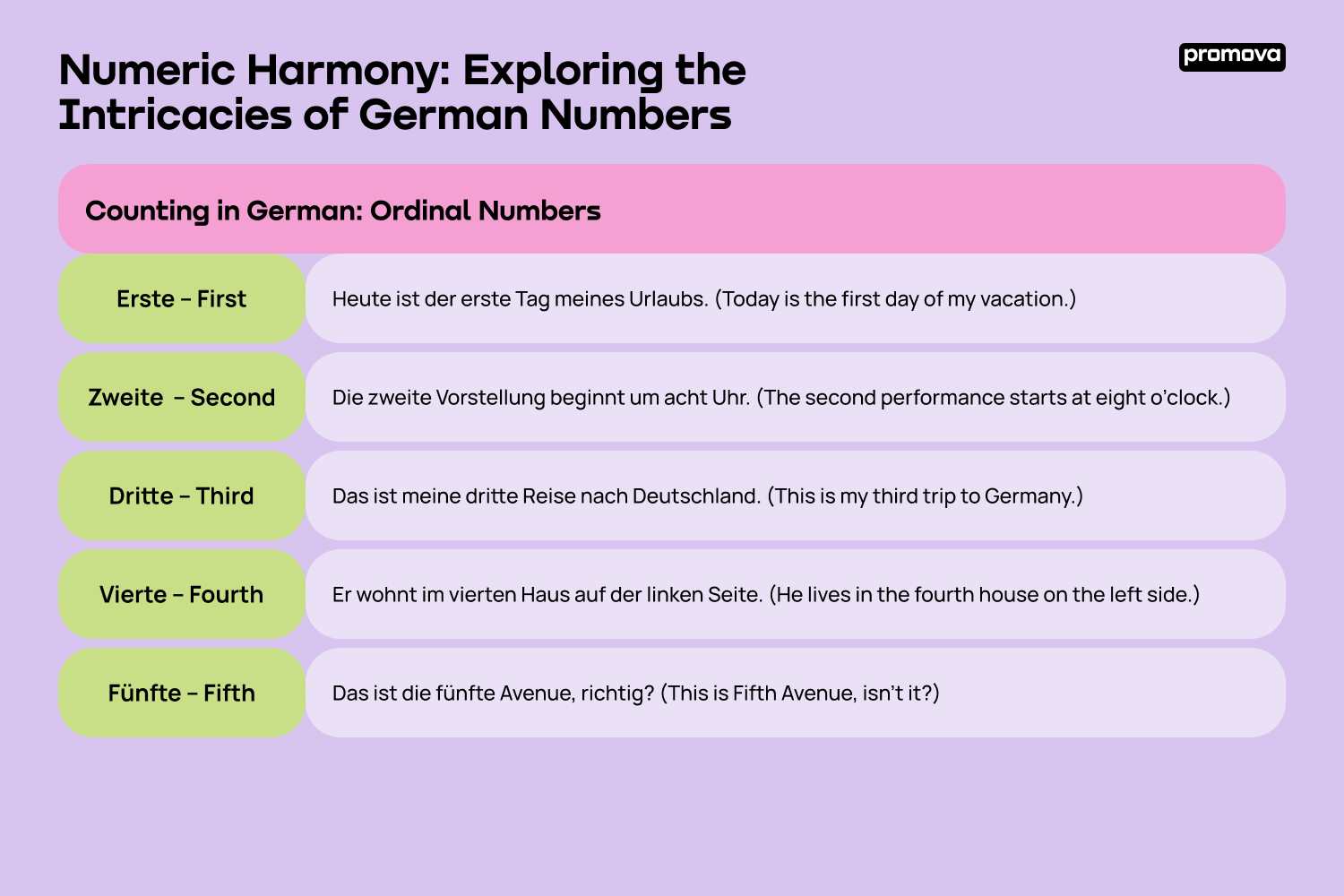Numeric Harmony: Exploring the Intricacies of German Numbers


You will get a promo code with a discount for our app courses after reading this article.
Contents
Learning German numbers is essential regardless of your current fluency level. Without this knowledge, you won’t be able to state time, ask about prices, count things, and do many other common daily tasks. Therefore, today, you’ll explore the unique word of numerals in the German language and get all the basic information to understand this topic easily.
Basics of Numbers in German
Let’s start with simple cardinal numbers. Those numerals answer the question “How many?” and not “In what order?”. The best way to understand how to use German numbers is just by memorizing them. We hope that the information below will help you achieve this goal.
- Numbers from 1 to 12.
Like in English, German numbers from one to twelve are entirely different words that don’t follow the same pattern. You just need to understand the meaning and pronunciation, and voilà – you already know how to count 1-10 in German. Browse through this table for more information.
| 1 | Eins | [aɪns] |
| 2 | Zwei | [tsaɪ] |
| 3 | Drei | [dʁaɪ] |
| 4 | Vier | [fiːɐ] |
| 5 | Fünf | [fʏnf] |
| 6 | Sechs | [zɛks] |
| 7 | Sieben | [zi:bən] |
| 8 | Acht | [aχt] |
| 9 | Neun | [nɔʏn] |
| 10 | Zehn | [tsen] |
| 11 | Elf | [ɛlf] |
| 12 | Zwölf | [tsvølf] |
- Numbers from 13 to 19.
The next set of numbers, from 13 to 19, is similar to their English equivalents, as these numerals also follow a pattern. All words in this list start with a specific unit and end with zehn (ten). So, basically, you just join two numbers together.
| 13 | Dreizehn | [ˈdʁaɪt͡seːn] |
| 14 | Vierzehn | [ˈfiːɐt͡seːn] |
| 15 | Fünfzehn | [fʏnft͡seːn] |
| 16 | Sechzehn | [ˈzɛçt͡seːn] |
| 17 | Siebzehn | [ˈziːpt͡seːn] |
| 18 | Achtzehn | [ˈaxt͡seːn] |
| 19 | Neunzehn | [ˈnɔʏnt͡seːn] |
- Numbers from 20 to 100.
These numbers, like the previous ones, also follow a similar pattern. They all end with “zig” or “ßig” and have a corresponding number at the beginning. Check out this table for more examples.
| 20 | Zwanzig | [ˈt͡svan.tsɪç] |
| 30 | Dreißig | [ˈdʁaɪ̯sɪç] |
| 40 | Vierzig | [ˈfiːɐ.tsɪç] |
| 50 | Fünfzig | [fʏnftsɪç] |
| 60 | Sechzig | [ˈzɛçtsɪç] |
| 70 | Siebzig | [ˈziːp.tsɪç] |
| 80 | Achtzig | [ˈaxt.tsɪç] |
| 90 | Neunzig | [ˈnɔʏntsɪç] |
| 100 | Hundert | [ˈhʊndɐt] |
All the numbers between 20 and 100 in German follow the same pattern – 32 is 2 and 30, 56 – 6 and 50, etc. To create them, you should use the conjugation und (and). Here are some examples:
| 87 | Siebenundachtzig | [ˈziːbənʊntˈaxt͡sɪç] |
| 56 | Sechsundfünfzig | [zɛksʊntˈfʏnfzɪç] |
| 32 | Zweiunddreißig | [ˈtsvaɪʊntˈdʁaɪ̯sɪç] |
| 22 | Zweiundzwanzig | [ˈtsvaɪʊntˈt͡svantsɪç] |
Counting beyond a hundred in German involves a straightforward system similar to English. Once you’ve mastered the numbers up to 100, the pattern repeats itself. All you need to do is to start with the hundreds place, then add the tens and ones. For example, 101 is einhunderteins, and 245 is zweihundertfünfundvierzig. To express thousands, you add the word Tausend [ˈtaʊ̯zn̩t] after the corresponding number. For instance, 1,000 is eintausend and 3,500 is dreitausendfünfhundert.
10
Counting in German: Ordinal Numbers
Now that you are familiar with most cardinal numbers in German, it is time to move to our next step – ordinal ones. They are used to show the position of something in the list of things. In English, ordinal numbers are first, second, etc. And if you are wondering how to say numbers in German, don’t worry – you just need to memorize this simple structure: der/die/das + number + -te/-este. The only word that doesn’t follow this pattern is the number first.
- Erste – [ˈɛʁstə] – First.
Heute ist der erste Tag meines Urlaubs. (Today is the first day of my vacation.)
Sie hat den ersten Platz im Wettbewerb gewonnen. (She won first place in the competition.)
Das ist das erste Buch, das ich je gelesen habe. (This is the first book I’ve ever read.)
- Zweite – [ˈtsvaɪ̯tə] – Second.
Die zweite Vorstellung beginnt um acht Uhr. (The second performance starts at eight o’clock.)
Der zweite Stock ist das Büro des Direktors. (The second floor is the office of the director.)
Mein zweiter Bruder studiert Medizin. (My second brother is studying medicine.)
- Dritte – [ˈdrɪtə] – Third.
Das ist meine dritte Reise nach Deutschland. (This is my third trip to Germany.)
Der dritte Abschnitt des Buches ist besonders spannend. (The third section of the book is particularly exciting.)
In der dritten Klasse habe ich Deutsch gelernt. (I learned German in the third grade.)
- Vierte – [ˈfɪʁtə] – Fourth.
Er wohnt im vierten Haus auf der linken Seite. (He lives in the fourth house on the left side.)
Die vierte Staffel der Serie ist sehr fesselnd. (The fourth season of the series is very gripping.)
Ich habe heute Morgen meine vierte Tasse Kaffee getrunken. (I had my fourth cup of coffee this morning.)
- Fünfte – [ˈfʏnftə] – Fifth.
Das ist die fünfte Avenue, richtig? (This is Fifth Avenue, isn’t it?)
Die fünfte Prüfung war die schwierigste. (The fifth exam was the most challenging.)
Ich habe gestern meine fünfte Sprache gelernt. (I learned my fifth language yesterday.)
- Sechste – [ˈzɛçstə] – Sixth.
Das ist die sechste Etage des Gebäudes. (This is the sixth floor of the building.)
Die sechste Stunde ist meine Lieblingsstunde. (The sixth hour is my favorite time.)
Sie hat in der sechsten Klasse angefangen, Klavier zu spielen. (She started playing the piano in the sixth grade.)
- Siebte – [ˈziːptə] – Seventh.
Er hat die siebte Symphonie von Beethoven komponiert. (He composed Beethoven’s Seventh Symphony.)
Die siebte Person in der Reihe ist mein Bruder. (The seventh person in line is my brother.)
Die siebte Woche des Jahres ist oft sehr stressig. (The seventh week of the year is often very stressful.)
- Achte – [ˈʔaxtə] – Eighth.
Das ist das achte Kapitel des Buches. (This is the eighth chapter of the book.)
Die achte Reihe im Kino bietet die beste Sicht. (The eighth row in the cinema offers the best view.)
Sie feiern ihren achten Hochzeitstag in Paris. (They are celebrating their eighth wedding anniversary in Paris.)
- Neunte – [ˈnɔɪ̯ntə] – Ninth.
Die neunte Klasse hat einen besonderen Ausflug gemacht. (The ninth grade had a special field trip.)
Das ist die neunte Wiederholung des Experiments. (This is the ninth repetition of the experiment.)
Die neunte Person in der Schlange hat eine Frage. (The ninth person in line has a question.)
- Zehnte – [ˈtsɛntə] – Tenth.
Das ist die zehnte Ausgabe dieser Zeitschrift. (This is the tenth edition of this magazine.)
Die zehnte Minute des Spiels war entscheidend. (The tenth minute of the game was crucial.)
Wir haben das zehnte Jubiläum unserer Firma gefeiert. (We celebrated the tenth anniversary of our company.)

Bonus! German Number Idioms Worthy of Your Attention
And now, it is time to learn something really cool – and yes, we are talking about idioms. The German language has tons of unique sayings, and some of them actually contain different numbers. Therefore, it is time to not only learn how to count to 100 in German but also memorize some popular sayings.
- Zwischen zwei Stühlen sitzen – [ˈtsvɪʃən t͡svaɪ̯ ˈʃtyːlən ˈzɪtn̩] – To sit between two stools.
Have you ever been in a situation where you needed to choose between two entirely different options and, as a result – failed to do anything? If yes, it means that you were caught between two stools, which is the meaning of our first idiom.
- Alle guten Dinge sind drei – [ˈalə ˈɡuːtn̩ ˈdɪŋə zɪnt draɪ] – All good things come in threes.
In English, we would call it “third time’s a charm.” Germans, on the other hand, say that all good things come in threes. And while the wording is quite different, the meaning remains the same – if you fail to succeed twice, the thing will definitely work out on the third time.
- Buch mit sieben Siegeln – [buːχ mɪt ˈziːbən ˈziːɡəln̩] – A book with seven seals.
Germans use this idiom to say that they don’t understand something at all. But the origins of this proverb are quite more romantic. It is the reference to The Book of Revelation, the final book of the New Testament, where specific information was secured by seven seals.
How to Count in German: Practice with Promova!
If you are looking for a convenient way to master foreign tongues on the go, we’ve got you covered! The Promova app is a modern language-learning platform that provides you with the most valuable studying experiences. Here are just a few benefits you receive minutes after installing the app:
- You can choose from numerous languages to learn, including German, French, English, Korean, Spanish, and others.
- You can practice anywhere and anytime.
- You access engaging interactive lessons created by true language professionals.
- You can track your progress and stay motivated while studying.
- You can practice bite-sized learning and achieve your goals at your own pace.
The Promova app is available for different devices on iOS and Android systems. Downloading it takes only a few seconds, but the impact on your fluency level and language-learning experience is much more long-lasting. So what are you waiting for? Get the Promova now, and follow your dreams of mastering a new language. And we will always be here to help.
Conclusion
To sum up, we can say that after learning to count to one hundred in German, you can easily understand higher numbers, up to millions, and more. We hope today’s article was useful, and we look forward to seeing you in the next one!
Use your discount and learn languages with Promova
Start learningFAQ
What are the best tips for memorizing German numbers?
Remember that repetition is key to memorization. Integrate numbers into your daily routine, such as counting objects, telling time, or reciting phone numbers. The more you encounter and use German numbers, the easier they become to remember. Also, try to break down larger numbers into smaller, more manageable chunks. It will help you avoid feeling overwhelmed and memorize all the numbers you need efficiently.
How do you call different mathematical expressions in German?
Plus and minus are almost identical to their English equivalents – for example, 5 + 3 is fünf plus drei, and 10 – 7 is zehn minus sieben. Multiplication in German is “mal” or “malnehmal,” and division is called “geteilt durch.”
How do you express fractions in German?
For simple fractions, use the word “halb” (half) – e.g., 1/2 is “eins halb.” In the case of other fractions, use the ordinal number for the numerator and the cardinal number for the denominator (e.g., 3/4 is “drei viertel”)
What’s so special about the number 21 in German?
In German, the number 21 is unique in its structure. Instead of following the usual pattern of stating the tens place before the units place, 21 places the units place before the tens place – einundzwanzig (one and twenty). This exception is important to note when learning German numbers to avoid common mistakes in pronunciation and structure.



Comments